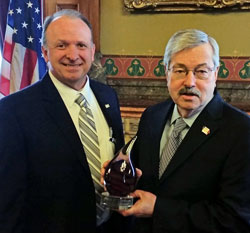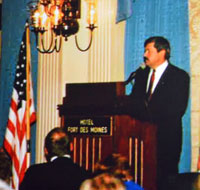The latest study on the economic impact of the ethanol industry released at the National Ethanol Conference this week shows the renewable fuel added $44 billion to the nation’s gross domestic product and supported nearly 360,000 jobs last year.
 The study, conducted by ABF Economics, quantified the impact of domestic ethanol production in 2015 on the national economy. “It really highlights the enormous contribution this industry makes to our nation’s economy and workforce, particularly in rural areas,” said Renewable Fuels Association Senior Vice President Geoff Cooper. He notes that the ethanol industry also helped boost household income by $23.5 billion and increased federal, state and local taxes by $8.7 billion.
The study, conducted by ABF Economics, quantified the impact of domestic ethanol production in 2015 on the national economy. “It really highlights the enormous contribution this industry makes to our nation’s economy and workforce, particularly in rural areas,” said Renewable Fuels Association Senior Vice President Geoff Cooper. He notes that the ethanol industry also helped boost household income by $23.5 billion and increased federal, state and local taxes by $8.7 billion.
“We also look at the impact on the economy from displacing oil consumption,” Cooper added. “The industry produced 14.7 billion gallons of ethanol last year, which was a record, and that meant we didn’t need to import 527 million barrels of crude oil.”
Listen to an interview with Cooper here: Interview with Geoff Cooper, RFA
 While the economic benefits of ethanol may be less significant today with lower oil prices, the higher octane benefits of the renewable fuel are unaffected by price fluctuations. Cooper hosted two panels at the NEC this year focused on those high octane benefits. “Ethanol’s octane rating of about 113 is far superior to the octane rating of other gasoline components that come out of a refinery and that makes ethanol extremely valuable to refiners and gasoline blenders,” said Cooper.
While the economic benefits of ethanol may be less significant today with lower oil prices, the higher octane benefits of the renewable fuel are unaffected by price fluctuations. Cooper hosted two panels at the NEC this year focused on those high octane benefits. “Ethanol’s octane rating of about 113 is far superior to the octane rating of other gasoline components that come out of a refinery and that makes ethanol extremely valuable to refiners and gasoline blenders,” said Cooper.
One panel on Tuesday focused on “Octane 101” and a Wednesday panel went into more detail on the economic and environmental benefits of higher octane fuels. Experts on that panel included Robert McCormick with the National Renewable Energy Laboratory; Confluence Consulting president Vincent Kwasniewski; and Platts biofuels analyst Jordan Godwin.
Listen to that panel here: Second NEC Octane Panel











